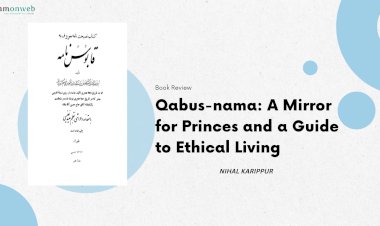Development of Literature During the Mughal Era
The Mughal rulers dominated the Indian subcontinent for an extensive period, leaving an indelible mark through their contributions to art, architecture, and literature. The grand historical monuments that still stand today serve as enduring reminders of their legacy. While the Mughal era is widely recognised for its architectural achievements, its significant contributions to literature are often overlooked. This study aims to highlight the Mughals' impact on literary development.
The Mughal rulers were great patrons of the arts and literature, showing a deep interest in languages such as Persian and Urdu. They facilitated the translation of works between Sanskrit, Persian, and Turkish. The golden period of Urdu poetry, spanning the 18th and 19th centuries, can be considered one of the Mughals' greatest contributions to Urdu literature, as they created a conducive environment for its flourishing[1].
During the Mughal period, Persian was the predominant language of administration, and numerous literary works were composed in it. Its prominence grew especially in northern India, where the Mughal capital was located, and it became the language of the ruling elite[2]. Akbar, in particular, contributed to this by transitioning from local languages to Persian for official income records, further solidifying its widespread usage across Mughal India.
Several factors contributed to the flourishing of literature during the Mughal era. The rise of regional languages like Hindi and Gujarati was significantly driven by the Sufi and Bhakti movements. Sufi and Bhakti saints used local languages to communicate with the masses, fostering the development and spread of regional languages throughout India.
It is also noteworthy that Babur, the founder of the Mughal dynasty, was a talented poet and writer. His memoir, the Baburnama, earned high acclaim among scholars. Initially written in Turkish, it was later translated into various languages, further exemplifying the Mughals' literary legacy.
Literature During the Reign of Babur and Humayun
Babur, the founder of the Mughal dynasty, had a deep interest in literary works. He authored Tuzuk-i-Baburi in Turkish, a memoir so well written that it was translated into Persian on three separate occasions. In addition to his memoir, Babur composed poetry in both Turkish and Persian, and his collection of Turkish poems, Divan, became widely known.
After Babur's reign, his son Humayun ascended the throne. Humayun's sister, Gulbadan Begum, wrote the Humayunama, a historical account of his life and reign, which is considered an important contribution to Mughal historiography. Humayun was also an avid patron of literature and established a vast library known for its extensive collection of manuscripts. Unfortunately, Humayun met his untimely death after falling down the stairs of this very library.
Literature During the Reign of Akbar
Akbar, the Mughal emperor, had a profound appreciation for art and literature. He built a vast library that housed over 24,000 manuscripts[3] and actively supported numerous scholars, writers, and poets, resulting in a flourishing of literary works during his reign. Prominent scholars such as Abul Fazl, Faizi, Nizamuddin Ahmed, and Abbas Khan emerged during this period[4], making significant contributions to literature. Many historical works were commissioned and completed under Akbar’s rule.
Abul Fazl bin Mubarak, one of the "Navaratnas" (nine jewels) in Akbar's royal court, authored the Akbarnama, a comprehensive account of Akbar’s reign. Another scholar, Abdul Hamid Lahori, a disciple of Abul Fazl, wrote the Padshahnama, which chronicles the history of Shah Jahan's reign. Akbar's thirst for knowledge also led to the translation of various Sanskrit works into Persian. For example, the Mahabharata was translated as the Razmnama[5], recounting the ancient battle between the Kauravas and Pandavas. Faizi, another court scholar, translated the Bhagavad Gita from Sanskrit into Persian. Akbar also facilitated the translation of several other Sanskrit texts, including the Ramayana, the Upanishads, Sanghasan Batisi, and Hayat al-Haiwan[6].
In Akbar's court, literary forms such as Rubaiyat and Ghazal flourished. He ensured that exceptional poets received proper guidance by appointing skilled teachers to instruct in the arts. Whether it was a Ghazal or a Qasida, the literary culture of Akbar's reign thrived under the mentorship of great masters[7].
In Akbar's time, stories were often regarded as history[8], and this era was marked by the flourishing of the Persian language and literature. Even brief mentions of writing and speech from this period reflect a literary richness that later defined the Mughal culture and civilisation. The period of Ada Akbari is often considered a pivotal moment in Indian history due to Akbar's extensive support for the sciences and arts, which laid the foundation for the Mughal cultural legacy.
Scholars such as Abdul Qadir Badayuni, Faizi, Abul Fazl, and Nizamuddin were prominent figures in Akbar’s court, where Persian literature experienced significant development. However, Akbar also contributed to the advancement of Sanskrit[9]. In Ain-i-Akbari, the names of fifty-nine poets from Akbar's royal court are mentioned. Besides these poets, there were Sanskrit scholars, many of whom were proficient in both Persian and Sanskrit.
Additionally, one of the notable figures of Akbar's reign was Khan-i-Khanan, who is considered one of the great Hindi poets. Famous Hindi poets like Raja Birbal, Man Singh, and Bhagwan Das were also closely associated with Akbar’s court. Tulsidas and Surdas, two renowned scholars of the Mughal era, made immortal contributions to Hindi literature with their works.
Moreover, a Sanskrit-Persian dictionary titled Parsi Prakash was composed during Akbar’s reign, highlighting his efforts to bridge linguistic and cultural divides.
Literature During the Reign of Jahangir
Jahangir, like his grandfather Babur, had a strong interest in art and architecture. He also penned his autobiography, the Tuzuk-i-Jahangiri or Jahangirnama, which is an important historical account of his reign. Another notable work from this period is the Iqbalnama-i-Jahangiri, which holds significant literary and historical value.
Literature During the Reigns of Shah Jahan and Aurangzeb
Shah Jahan's son, Dara Shikoh, made a remarkable contribution to Sufi literature with his famous work Majma-ul-Bahrain (The Confluence of the Two Seas), in which he explored the diversity of religions and emphasised the harmony between Islam, Hinduism, and other faiths. He also oversaw the translation of important Hindu texts, including the Bhagavad Gita and the Upanishads, into Persian[10].
One of the most significant historical works from Shah Jahan's reign is the Padshahnama, a detailed account of his kingdom written by Abdul Hamid Lahori. This monumental book remains an important source of information about his era.
During the rule of Aurangzeb, one of the most significant literary contributions was the Fatawa-e-Alamgiri, a comprehensive compilation of Islamic law that holds immense importance in the field of jurisprudence. Other notable works from this period include Nuskho-i-Dilkusha by Bhimsen, Alamgirnama by Muhammad Kazim bin Muhammad Amin[11], and Muntakhab-ul-Lubab by Kafi Khan[12].
Translated Literature
During this period, many Sanskrit works were translated into Persian, including two major Sanskrit epics, the Mahabharata and the Ramayana. A notable figure of this era was Jagannatha Panditaraja, a renowned Telugu poet and literary critic known for his works such as Rasa Gangadharam and Ganga Lahari, among others.
Regional Literature
Regional languages like Bengali, Gujarati, Oriya, and Rajasthani also experienced significant development during this era, largely through translations. One example of this progress was translating stories from the Bhagavad Gita into these regional languages. Urdu emerged as the lingua franca, enabling people from different linguistic backgrounds to communicate more easily. Additionally, the common people played a crucial role in promoting and uplifting regional languages, helping them evolve into prominent literary languages.
Hindi Literature
Hindi poets held a prominent place in the Mughal courts, with several gaining high regard for their contributions. Among them, Tulsidas was one of the most renowned Hindi poets, and he was known for his works written in both Sanskrit and Awadhi. His literary masterpieces have left a lasting impact on Hindi literature.
Another significant figure was Surdas, famously known as the "blind bard of Agra." He was a prominent poet in Akbar's royal court and is celebrated for his devotional poetry. During the reign of Shah Jahan, Sundar Kaviray made his mark with the composition of Under Shringar, which further enriched the Hindi literary tradition.
Promotion of Urdu During the Mughal Era
The Mughals, particularly the later kings, played a crucial role in the development and evolution of the Urdu language. They patronised poets and writers, creating an environment conducive to the growth of Urdu. Mughal emperor Muhammad Shah was particularly known for his fondness for Urdu and its promotion. He invited and honoured the famous Urdu poet Shamsuddin Wali for his contributions to Urdu poetry. Similarly, the last Mughal emperor, Bahadur Shah Zafar, was himself a poet and regularly organised literary events at his court.
Famous poets of the Mughal era, such as Mir Taqi Mir, Sauda, and Mirza Ghalib, left a profound impact on the development and evolution of Urdu literature. The language gained further prominence as it became the official court language during the reign of the Mughal emperors. Kings like Muhammad Shah and Bahadur Shah Zafar patronised not only literary works but also calligraphy and mushairas (poetry gatherings) at their palaces.
The term "Urdu" is believed to have originated in the army camps of Delhi, where soldiers from various regions of Hindustan communicated using a language that blended words from different languages[13]. The emergence of Urdu as a significant literary medium during the Mughal era was driven by two key factors: its use as a means of communication and the richness of the literary content it produced. Urdu was heavily influenced by Persian and Arabic, contributing to its distinct form and elegance.
Conclusion
The Mughal era marked a period of significant literary advancements, with the creation of numerous original and translated works. While Persian remained the dominant language, literature in Sanskrit, Hindi, Urdu, and various regional languages also flourished. This era saw the elevation of these languages through the production of new literary compositions and the adoption of innovative techniques. The patronage of Mughal kings, princes, scholars, and even the common people played a crucial role in nurturing this literary progress. The rich collection of works produced during this period laid a strong foundation for future generations of writers, influencing the course of literature in the Indian subcontinent.
References
[1] Laal, Waaz Author, The History of the Urdu Language, Mujtabai Press, Delhi
[2] Suhasinisinha, Literature During the Mughal Empire, https://www.geeksforgeeks.org/
[3] Anu Kumar, How Akbar came to love books though he never learnt to read, scroll.in, https://scroll.in/article/767632/how-akbar-came-to-love-books-though-he-never-learnt-to-read
[4] Suhasinisinha, Literature During the Mughal Empire, https://www.geeksforgeeks.org/
[5] ibid
[6] Sheikh Muhammad Ikram, Rood E Kausar, p. 164, https://archive.org/details/RoodEKausar_201607/page/n159/mode/1up
[7] Muhammad Mubarak Hussain, The situation of sciences, arts and civilization and culture in Ada Akbar, https://ncpulblog.blogspot.com/
[8] Suhasinisinha, Literature During the Mughal Empire, https://www.geeksforgeeks.org/
[9] Ram Prasad Tripathi, Rise and Fall of the Mughal Empire, Central Book Depot, Allahabad
[10] Suhasinisinha, Literature During the Mughal Empire, https://www.geeksforgeeks.org/
[11] Shamsul Ulama Moulvi Zakaullah, Aurangzeb Alamgeer, Farid Book Depot, New Delhi, p 472
[12] Shamsul Ulama Moulvi Zakaullah, Aurangzeb Alamgeer, Farid Book Depot, New Delhi, p 473
[13] Saif Mahmood, Mughal Delhi's Romance With Urdu Poetry, www.outlookindia.com
About the author:
Noor Hasan, Senior Secondary final year student of Darul Huda Punganur, is from Sitamarhi, Bihar.
Disclaimer
The views expressed in this article are the author’s own and do not necessarily mirror Islamonweb’s editorial stance.

























Leave A Comment